Men's magazines: an A to Z
Men's magazines, lads magazines, glamour magazines, pin-up magazines and top-shelf magazines covered alphabetically. This page addresses Nine to Playboy, via Parade and Penthouse. On other pages:
Introduction
- 3D titles to Boys Toys
- Carnival to Cut
- Deluxe to Esquire
- Fable to Front
- The Gentleman's Magazine to The Humorist
- Ice to London Opinion
- Man to Maxim
- Mayfair to Monkey
- Nine to Playboy (this page)
- Razzle to Switched On
- T3 to Zoo Weekly
NineNine Magazine, published under licence by PML, London. Oct/Nov 2002-?Editor C. Cushnie was 'committed to producing an innovative, contentious and provocative publication'. He went on: 'we are about wine, women and song ... Every issue we will bring you some of the hottest black women Britain has to offer...' Nine carried plenty of flesh but not topless. |
 IPC set out to create a new weekly sector for men's magazines with Nuts  Poster promoting Striker football cartoon strip in Nuts |
NutsIPC Media, January 2004-2014IPC gave away a million free copies of Nuts at branches of WH Smith and sent out copies with media trade magazines to launch its men's weekly and establish a new sector. Launch costs for Nuts were estimated at £8m. The next week's issue (23 January) was sold for 60p, half the aimed-for regular price. The weeklies Nuts and Zoo took away younger readers from the men's monthlies, Loaded and FHM, and also hit tabloid papers such as the Sun. Sales of Nuts stayed ahead of Zoo, peaking at about 300,000. However, they were both seen off by the web, along with their monthly bretheren, by 2015. Final sales were 53,000. In the 29 Jan 2010 issue, Nuts relaunched with the 3D computer-generated football cartoon strip Striker, which had appeared in both the daily Sun newspaper and in the launch issue of rival men's weekly Zoo before being launched as a standalone comic that closed in 2004. The addition was part of a £500,000 promotional push at 49 football grounds across the UK ahead of the World Cup in South Africa. Nuts editor Dominic Smith said: '[Readers] said they wanted more from Nuts. They told us they love our classic mix of girls, sport, news, humour, gadgets and gear. The new look delivers a fresher, more modern feel to reinforce that mix, while introducing a new range of must-read editorial franchises every week, including an all-new Striker.” An advertising campaign in football grounds included six-sheet posters and TV screens in washrooms and concourses designed to reach 1.8 million football fans. |
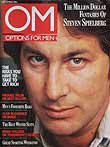 Steven Spielberg on the first issue of Options for Men as a supplement to Options in
December 1984
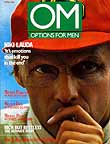 F1 racing driver Niki Lauda on the cover in April 1985, with Michael Caine in December, below 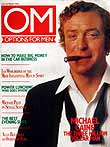
|
OM / Options for Men [closed]Carlton, December 1984-December 1988Reed subsidiary Carlton put out Options for Men as a supplement to women’s monthly Options in December 1984. Options for Men covered fashion, motoring, sport and entertainment. The company had hopes of a standalone quarterly in 1985, though this did not come about. However, OM went out as a supplement three times in 1985 and 1986 and was quarterly in 1987, which led the company again to talk of a separate launch in 1989, but it did not see the light of day. Sally O'Sullivan was editor. IPC profile |
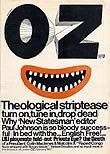 First issue of underground magazine Oz, above. In April 2006,
a copy sold on eBay for £360 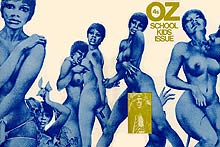 The School Kids Issue triggered an obscenity trail 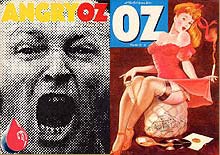 Two covers for issue 37: Angry Oz and A World of Young Love 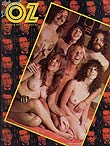 The last issue (issue 48) carried a photograph of the staff, naked. Felix Dennis is on the top right |
OzJanuary 1967-November 1973Oz was an underground magazine set up in Australia originally by editor Richard Neville and artist Martin Sharp. They came to 'swinging London' and brought the concept with them. Although not strictly a men's magazine, it is included here as the training ground for Maxim founder Felix Dennis. The magazine broke all the publishing and design rules and was highly creative and influential. The cover ran around the front and back of the School Kids Issue, for example, and issue 37 (September 1971) could be read from either end as A World of Young Love (portraying sex and drugs and rock 'n' roll) or Angry Oz. In 1971, Oz was the subject of an infamous obscenity trail that held Briton in thrall. Three men – Richard Neville Felix Dennis (later founder of Maxim publishing empire) and Jim Anderson were prosecuted for conspiracy under the UK's Obscene Publications Act 1959 over 'sexually perverted cartoons and articles' in the School Kids Issue (issue 28, May 1970). Sentences of up to 15 months sparked protests from John Lennon and many others. The convictions were quashed on appeal. Oz sales rose to 80,000 but the magazine closed in 1973 (issue 48). Official papers released in 1999 showed that the authorities held an inquiry into the accusation that police were prosecuting hippie publications such as Oz and the Little Red Schoolbook while Soho pornographers paid bribes to avoid jail. The resulting anti-corruption drive saw the jailing of the senior officer responsible for the Oz prosecution; 400 other officers were imprisoned or left the force. See Tony Palmer's book Trials of Oz for details. Weed's Oz links and covers |
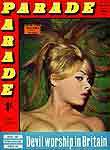 Parade in 1961
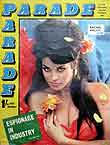 Parade in March 1965 had a pin-up colour centre spread of actresses, such as Raquel Welch, but there were no topless pictures 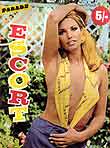 Parade Escort in 1967. A special issue of stories and pin-ups (many in colour) and an A3 poster. It cost 5/- for 84 pages and was perfect-bound 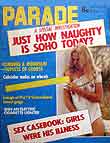 Parade in 1972 had become more raunchy with a naked colour centrefold and other topless pictures |
ParadeCity Magazines/Williams Publishing/GSP, 1958-Blighty the pocket war-time humorous / pin-up weekly men's magazine, was relaunched several times with the Parade name, dropping the Blighty name in 1960:
|
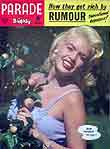 Parade and Blighty (21 November 1959) in the evolution
of Blighty into Parade with Jayne Mansfield on the cover. This was the second issue under the new name |
Parade and Blighty [closed]City Magazines, 45 St Pancras Way, NW1. Printed by Eric Bemrose, Long Lane, Liverpool 9.The issue shown here (21 November 1959; no 1041) was the second under the title Parade & Blighty. Jayne Mansfield was on the cover. An inside feature showed Claire Gordon on the set of the 1959 film Beat Girl as David Farrar's maid (the film also starred Christopher Lee and Oliver Reed); frequent cover pin-up Shirley Ann Field was also in the film. The colour centre-spread pin-up was of Carol Stevens. There was also a comic strip series, 'Claws of Death'. It cost 6d and ran to 40 pages. see Parade |
|
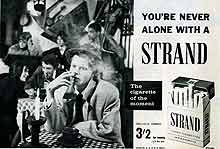 'You're never alone with a Strand. The cigarette of the moment.' Parade & Blighty (5 November 1960) ran a half-page advert for Strand cigarettes. This campaign backfired because, although actor Terence Brooks and the theme music to the TV campaign became famous, sales were poor. Strands were withdrawn when it became clear the public associated the cigarettes with being lonely
|
||
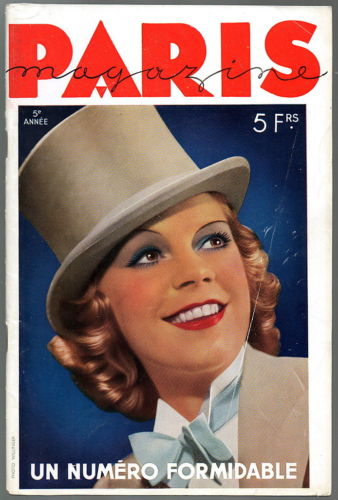 Paris in 1935
with an excellent colour cover 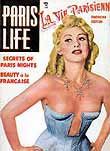 Paris Life, in 1952. This was a US version of La Vie Parisienne, a French title that also inspired London Life |
Paris Magazine [closed]Paris Magazine was a popular French title with excellent production values – the issue shown here dates from 1935. Such titles influenced the British market; others were distributed in the UK; and the content was sometimes republished in English by British publishers. |
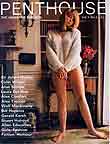 Penthouse was launched by Bob Guccione and made a fortune for Richard Desmond |
PenthousePenthouse/Northern & Shell/Portland, March 1965-Upmarket top-shelf mens magazine. Launched by Bob Guccione, a US photographer who had worked on Playboy. Penthouse was the first of the UK titles to adopt a Playboy format, carrying lifestyle and mainstream articles among the pin-ups. Seen as more aggressive than Playboy, in its April 1970 issue, Penthouse showed a woman's pubic hair. Almost all the other upmarket top-shelf magazines quickly followed suit. The first issue was launched from a studio on London's Fulham Road and was published simultaneously in the US from a New York office. It cost 5s for 76 pages. Among three topless photo shoots (including Denise Johns – 'an 18-year-old poetess who dwells lightly amid all the confusion of Camden Town' – on the cover and as the first centre spread 'pet of the month') were articles by Wolf Mankowitz, Sir Julian Huxley and Gerald Kersh. Photographs were by Adrian Hamilton, Murray Irving and Roy Cuthbert. Like many magazines of the time, Penthouse was a stapled title that interleaved cheap uncoated paper among its glossy pages. It also rationed the use of colour sections – more than half of the pages were in black and white. Very successful internationally. Richard Desmond's Northern & Shell/Portland group – now publishers of OK! and the Express papers – made its money by taking on the Penthouse franchise in the UK before expanding into niches such as Asian Babes and Forty-Plus. An issue in 1984 was reported as selling 5.3 million copies. The group also launched a CD-Rom version and website.In 1998, in the face of the threat from websites and lad's mags
such as Maxim in the US, the magazine became more sexually
explicit. The UK edition, now under US control, tried a less-explicit
route using fashion photographers to produce an 'adult magazine
for grown-ups'. Both strategies failed and in 2003 the company
filed for bankruptcy and the title was put up for sale. It was
bought up and the title is still published by Penthouse Media
Group. Total circulation is below 350,000. |
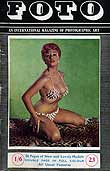 Photo issue 23 cost 1/6 for 56 pages, with a colour cover and centre spread |
Photo [closed]Axtell Pubs Ltd, Axtell House, Warwick Street, London W1. Blocks by Viaduct Process, Printed by Dyson Bros, Peterborough. Ed: John E Cross. Photo declared itself to be 'an international magazine of photographic art' – a euphemism for a glamour pin-up magazine.The cover and centre spread of the issue here were by glamour photographer Harrison Marks. The issue included a profile of model agent Pat Glover ('Glamour is his business'), who had earlier fame as England's youngest ballroom demonstrator, aged eight. His 'seven steps to fame for a young aspiring model' were: common sense; individual personality; good grooming; dress sense; make-up; neat hair; and elocution. The cover model was Pamela Green. (Back cover advert was for Beat magazine – 'Britain's fastest selling music magazine'.) Photo used good quality gloss paper throughout and to support colour on the outer cover and centre spread. 'Through these pages pass the most beautiful girls in the world,' declared the contents page. |
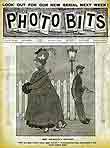 Photo Bits issue 499 on 18 January 1908. Cover cartoon by 'The Snark' 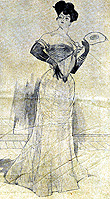 Detail from Photo Bits cartoon |
Photo Bits [closed]Printed and published for the Phoenix Press Ltd, Fleet Street, London EC. 32pp. 1d. Weekly on Fridays.9 July 1898-9 Dec 1916. Men's humour Cartoons, humorous stories, strips, jokes, glamour photographs and anecdotes made up the contents of Photo Bits. The size was 28cm x 21cm. The back two pages were taken up by classified adverts – mainly for 'rubber goods', nose improvements, moustache forcers (Brazilian and otherwise), tattooing, books for the married, amusing postcards and artistic photographs. Folded into Bits of Humour |
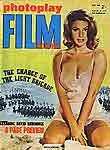 Photoplay in 1968 |
Photoplay [closed]Although not strictly a men's magazine, Photoplay relied for much of its appeal on pin-ups of film stars.Film & TV magazines |
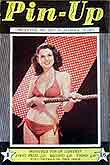 Pin-up magazine in the 1950s |
Pin-up [closed]Padiham, Lancaster. 1958?-Pocket pin-up men's magazine. |
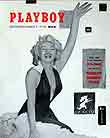 Playboy: a copy of the first issue sold on eBay for $2,050 in 2006 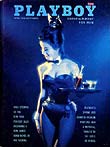
Playboy in 1996 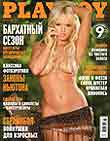 Ukraine issue 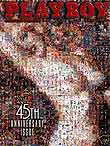 Playboy's 45th anniversary cover in 1999: the image was made up of images from previous issues |
PlayboyHugh Hefner Enterprises, 1953-Hugh Hefner's Playboy launched in 1953 in the US, selling for 50c. Marilyn Monroe was on the front cover and featured again, naked, inside. Playboy thrived in the US with a formula of good writing and pin-ups to lead men's magazines into an international era. Many titles were launched that wanted to be magazines like Playboy. Pipe-smoking Hugh Hefner, founder of Playboy, was parodied by the Pink Floyd in the comic programme that accompanied their 1994 concert tour. There have been many other parodies such as a 1971 issue of Punch with a naked woman cupping her breasts and the masthead 'Punch does Playboy'. In its October 2005 issue, Loaded branded itself as 'The Playboy UK issue' and ran promotions for the launch of the Playboy UK website. |
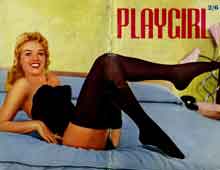 Playgirl magazine
used its cover image in an unusual way, with the front cover
designed as a 'teaser' for the whole image |
Playgirl [closed]L Miller & Son, Hackney Road, London; printed by 20th Century Press, London SE1. 1967?-?Playgirl was another magazine like Playboy, but this time for women. The first issue (2/6; 56pp) of this pocket pin-up magazine wrapped the image around the cover. Colour was used for the outer cover but the inside covers were spot blue. The middle four pages were in colour and devoted to 'Torrid Tina' with a montage centre-spread. A lot of the content – pin-ups, stories and cartoons – clearly came from the US (the cartoons were from the Chicago Tribune). There was a section at the back entitled 'Home Grown' of readers' photographs (1 guinea was paid for each). L Miller also published Flix, a film title based on Hollywood pin-ups. The first issue of Playgirl carried pictures of Lori Hilton, Gloria Pall, 'artistic stripper' Lili St Cyr and Maila (misspelt as Maile) Nurmi. Nurmi was a Finnish actress renowned for her tiny waist, who had played Vampira, a vampire-like TV hostess in the 1950s. After Vampira ended, Nurmi appeared in Plan 9 from Outer Space, often touted as the worst movie made, but now regarded as a camp classic, according to IMDB.There is also a US magazine called Playgirl that was founded
in 1973 as a Playboy for women. |



